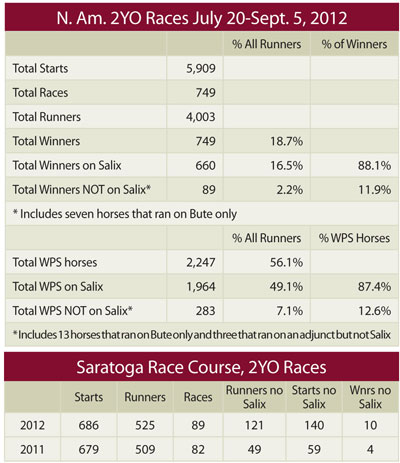Nearly two months have passed since a coalition of more than 60 owners launched an experiment into Salix-free racing, pledging to run their 2-year-olds without the controversial anti-bleeder medication (also known as Lasix) on race day.
Several trainers managing the medication-free horses say not enough time has gone by to ascertain any significant differences between the Salix and non-Salix runners in their barns, but they noted that none of the Salix-free horses have shown any signs of bleeding after their races so far.
"We scope every other time they work and every time they race," said trainer Graham Motion, whose barn had 25 juvenile starts between July 20 and Sept. 5 with 16 starts made without Salix. "I have been pleasantly surprised that we have not had more that have bled after a race."
The encouraging news has a caveat.
"I don't see this as any real form of information," said trainer Tony Dutrow, who had 27 juvenile starts during the same period, with 14 of the starts made without Salix. "Most first-time starters are limited in what is expected of them in their first race. A great deal of them are not putting into their first race what they will put into their subsequent races."
Motion, Dutrow, and a couple of other trainers all said they have not noticed an appreciable difference in the well-being of horses that have not been running on Salix versus the ones that have. In addition, none of them said they had reservations about not using the medication.
"I'm totally comfortable with running horses without Lasix," said Al Stall Jr., who won the Mountaineer Juvenile Stakes with Maybe So for owner Adele Dilschneider without Salix. "I am not doing anything different with them, just leading them to the paddock. If a horse bleeds, then we'll probably just give him some time off."
A chart on this page shows how the non-Salix horses have been performing. Between July 20 and Sept. 5, a total of 749 2-year-old races were run in the U.S. and Canada. Among the winners of those races, 660 (88.1%) ran on Salix and 89 (11.9%) did not.
Among horses that finished in the money, 87.4% raced on Salix and 12.6% ran without the medication.
Looking just at this year's Saratoga meet, the number of runners that were not given Salix the same day they raced rose to 121 from 49 during the 2011 meet. Ten horses without Salix became winners compared with four last year. The Blood-Horse compiled the statistics for 2012, while the 2011 statistics were provided by the Thoroughbred Owners and Breeders Association.
Trainer Kiaran McLaughlin, who has been racing 2-year-olds without Salix for a couple of years, agreed that not too much should be read into the early race records of juveniles.
"I just don't win first time out," McLaughlin said. "They always need a race. It has nothing to do with whether they are on Lasix or not."
Godolphin's grade I winner Alpha, a 3-year-old son of Bernardini that McLaughlin trains, didn't race on Salix as a juvenile. He did happen to win his first time out by six lengths, then came back to finish second behind Union Rags in the Champagne Stakes (gr. I). After Alpha turned 3, he began racing on Salix.
McLaughlin, however, added the juveniles that do not run on Salix have maintained their weight better and seem to recover more quickly after a race than the horses that do race on Salix. As for any bleeding?
"So far we have been very fortunate," he said. "We scope after every race and so far we have had only one that showed a tiny bit of blood. Other than that we have not seen any that have bled."
A couple of months of racing is certainly not enough to draw any conclusion, but the early results seem encouraging, even to the trainers.
"The way I see it, you would rather not take a pill in the morning than take a pill," said Stall. "It is good when a horse goes without Lasix and doesn't bleed. It feels good as the trainer when they are clean."
It feels good for the rest of the sport, too.





